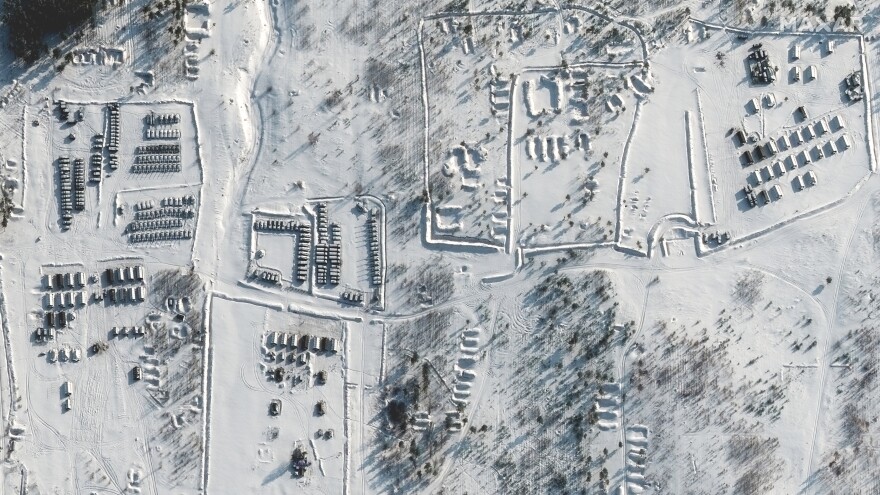Updated February 5, 2022 at 2:55 PM ET
The first of 2,000 U.S. soldiers newly deployed to Europe have arrived in Germany and Poland, military officials said, as part of the U.S. effort to buttress NATO's eastern flank as Russia gathers yet more forces along Ukraine's borders.
The troops arriving in Germany are 300 members of the 18th Airborne Corps, who will help to support joint task force headquarters operations there. Both units are based at Fort Bragg in North Carolina.
And in Poland, officers from the U.S. Army — including Maj. Gen. Christopher Donahue, the commanding general of the 82nd Airborne Division who was the last U.S. soldier to depart Afghanistan — arrived early Saturday at the Rzeszow-Jasionka Airport in the southeastern part of the country, roughly 50 miles from the Ukraine border.
Welcome to #Germany, @18airbornecorps!
— U.S. Army Europe and Africa (@USArmyEURAF) February 5, 2022
🇺🇸🇩🇪
See More: https://t.co/g1FIc24UD7#StrongerTogether #WeAreNATO pic.twitter.com/9DHEdAbliU
About 1,700 members of an 82nd Airborne infantry brigade combat team, a unit of paratroopers, are expected to arrive in Poland over the weekend.
President Biden ordered the deployments on Wednesday. Another 1,000 soldiers stationed in Germany will be repositioned eastward to Romania, which also shares a border with western Ukraine.
About 70,000 U.S. troops are permanently stationed in Europe. On top of that, 7,000 more soldiers are deployed on a rotational basis to the continent as part of a NATO support mission called Atlantic Resolve. Equipment arrived at a port in Poland on Friday as part of those rotations, including dozens of Stryker armored vehicles. At home in the U.S., 8,500 additional troops remain on high-alert "prepare to deploy" orders.
Biden and other U.S. officials have said that no U.S. soldiers will take part in combat in Ukraine.
Russia has moved thousands more troops to the border in recent weeks
The U.S. deployments come as new satellite images show the extent of the Russian military buildup along Ukraine's borders. More than 100,000 Russian troops are estimated to be deployed to locations in Belarus, western Russia and the Crimean Peninsula, the contested territory seized by Russia from Ukraine in 2014.
The most significant development shown in the new images is that many of Russia's deployment locations now include tents, the presence of which suggests that soldiers have arrived or will soon arrive, heightening their combat readiness.
Loading...
Sources watching Ukraine tell NPR that the number of Russian battalion tactical groups on the country's borders has increased to 83, up from 60 just two weeks ago. Another 14 are in transit. Each battalion has as many as 1,000 soldiers. Russia has increased its naval power, too, with amphibious landing ships and other warships gathering in the Black Sea.
For months, Ukrainian officials have publicly downplayed the danger of an imminent invasion — even as recently as Wednesday. "At this moment, by assessment of Ukraine and its partners, this number and composition of forces is not sufficient for a full-scale invasion," said Ukrainian Foreign Minister Dmytro Kuleba at a briefing.

But U.S. officials have taken a somewhat different line in recent days. About a week ago, Defense Secretary Lloyd Austin told reporters that Russia's forces could be enough to invade all of Ukraine.
"[Russian President Vladimir Putin] clearly is providing himself many options, lots more capabilities. For exactly what purpose? We don't know right now," said Pentagon spokesperson John Kirby in a press conference this week. "And because we don't know exactly what his purpose is, we want to make sure we're ready on the NATO front to defend our allies."
A large-scale invasion would likely have to take place before the end of March, experts say. The frozen ground in winter makes terrain more passable for cross-country movement of large forces; by spring, those routes will be muddy, boggy and more difficult to maneuver.
The timeline has put pressure on world leaders to find a diplomatic end to the crisis, and the week ahead holds another slate of high-level meetings.
French President Emmanuel Macron is scheduled to meet with Putin on Monday before traveling to Kyiv to meet with Ukrainian President Volodymyr Zelenskyy. German Chancellor Olaf Scholz is making the same rounds later in the week after a visit to the White House to meet with President Biden.
Copyright 2022 NPR. To see more, visit https://www.npr.org.




